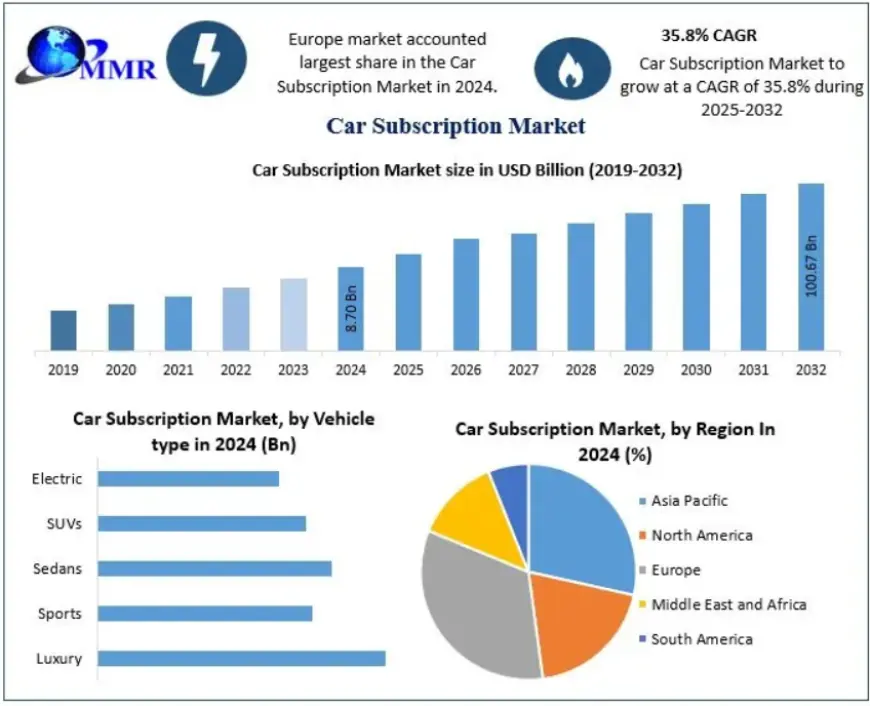Global Car Subscription Market Expands Amid Shift Toward Shared Mobility 2032
The Car Subscription Market size was valued at USD 8.70 Billion in 2024 and the total Car Subscription revenue is expected to grow at a CAGR of 35.8% from 2025 to 2032, reaching nearly USD 100.67 Billion.

Global Car Subscription Market Set to Transform Mobility Landscape with Rapid Growth, Reaching New Heights by 2030
Market Estimation & Definition
The Car Subscription Market is emerging as a transformative mobility solution in the global automotive ecosystem. The market, valued at USD 5.8 billion in 2023, is projected to grow at a CAGR of 35.6% from 2024 to 2030, reaching nearly USD 50 billion by 2030. This exponential rise underscores a fundamental shift in consumer behavior and automotive service delivery.
Car subscription refers to a flexible vehicle access model that allows customers to use a car through monthly or periodic payments without long-term commitments associated with car ownership or traditional leasing. Unlike leasing, car subscription packages typically include services such as maintenance, insurance, roadside assistance, and, in some cases, vehicle swaps. This model offers the flexibility of pay-as-you-go access and has gained strong traction among millennials, urban commuters, and corporations seeking agile fleet solutions.
By bridging the gap between car ownership, leasing, and ride-hailing services, the car subscription model has evolved as a hybrid mobility service designed for convenience, financial flexibility, and enhanced customer experience.
To know the most attractive segments, click here for a free sample of the report:https://www.maximizemarketresearch.com/request-sample/187723/
Market Growth Drivers & Opportunities
-
Shift in Consumer Preferences
A growing number of consumers, especially younger generations, prefer “usership over ownership.” The rising cost of owning and maintaining a vehicle, combined with urbanization and traffic congestion, has encouraged customers to explore flexible subscription models. -
Digital Transformation & Automotive Innovation
The rise of digital mobility platforms has accelerated the adoption of subscription services. Automotive manufacturers and third-party providers have built user-friendly apps that allow customers to subscribe, swap, or cancel vehicles with ease. -
Cost Transparency & All-Inclusive Benefits
Car subscriptions provide cost certainty by bundling expenses like insurance, registration, and maintenance into a single monthly fee. This simplicity is particularly appealing to urban professionals and families who seek hassle-free mobility. -
Sustainability and Electric Vehicle Adoption
With the global automotive industry moving toward sustainability, subscription services are increasingly offering electric and hybrid vehicles as part of their fleet. This trend is helping reduce carbon emissions while giving customers the opportunity to test EVs before committing to long-term ownership. -
Corporate and Fleet Opportunities
Small and medium-sized enterprises, along with large corporations, are turning to car subscription services as an alternative to traditional fleet leasing. The ability to scale fleets up or down based on operational needs presents significant cost advantages. -
Rural & Semi-Urban Market Penetration
While urban centers remain the core market, the expansion of subscription services into semi-urban regions offers vast untapped potential. Affordable packages, coupled with growing digital infrastructure, are opening new opportunities in these areas.
Segmentation Analysis
The Car Subscription Market is segmented across service providers, subscription type, vehicle type, end-users, and regions.
-
By Service Providers
-
Original Equipment Manufacturers (OEMs): Automakers are aggressively entering the subscription ecosystem by offering in-house solutions. Companies leverage their brand trust, dealer networks, and vehicle availability to attract consumers.
-
Third-Party Service Providers: Independent mobility platforms and startups dominate in urban hubs by offering multi-brand subscription options and flexible terms. They often partner with OEMs and dealerships to diversify offerings.
-
-
By Subscription Type
-
Single Brand Subscription: Customers subscribe to a specific brand, benefiting from brand loyalty programs and tailored services. Popular among luxury and premium vehicle customers.
-
Multi-Brand Subscription: Subscribers can switch between different brands and models depending on their needs. This segment is particularly popular among younger, experimental users who prefer diversity in mobility.
-
-
By Vehicle Type
-
Luxury Cars: High-net-worth individuals and professionals prefer subscription-based access to premium cars, avoiding the depreciation risks of ownership.
-
Economy Cars: This segment is driven by mass-market adoption, offering affordable, practical, and flexible mobility options for urban commuters.
-
Electric Vehicles (EVs): A rapidly growing segment, driven by the demand for sustainable mobility solutions. Many subscription companies offer trial EV programs to boost adoption.
-
-
By End-Users
-
Private Users: Individuals, families, and professionals constitute the largest customer base, drawn by affordability and convenience.
-
Corporate Users: Businesses increasingly leverage subscriptions for fleet management, benefiting from flexibility and reduced capital expenditure.
-
-
By Region
The market is expanding across North America, Europe, Asia-Pacific, Middle East, and South America, with significant growth led by technologically advanced and urbanized regions.
To know the most attractive segments, click here for a free sample of the report:https://www.maximizemarketresearch.com/request-sample/187723/
Country-Level Analysis
United States
The U.S. is a dominant player in the car subscription market, fueled by strong digital adoption, automotive innovation, and consumer preference for flexible ownership models. The presence of global automakers offering subscription programs, alongside mobility startups, creates a robust ecosystem. Additionally, corporate adoption of subscription services for fleet management has accelerated growth in metropolitan areas such as New York, Los Angeles, and Chicago.
Germany
Germany stands as a European hub for the car subscription model, supported by its automotive manufacturing base and sustainability goals. With government incentives for electric vehicles, many subscription services in Germany are focused on EVs and hybrids. The country’s strong middle-class population and tech-savvy urban residents have driven adoption, particularly in cities like Berlin, Munich, and Frankfurt. German automakers are heavily investing in in-house subscription models, further strengthening the market.
Competitor Analysis
The competitive landscape of the car subscription market is highly dynamic, with players ranging from established automakers to agile startups.
-
Automakers: Leading global manufacturers have launched their own subscription programs, leveraging brand trust, wide vehicle portfolios, and dealership networks. These companies focus on premium and luxury car subscriptions, targeting urban professionals.
-
Third-Party Platforms: Independent mobility service providers dominate the multi-brand segment, offering flexibility and affordability. Their competitive edge lies in technology-driven platforms, user-centric services, and adaptability.
-
Regional & Local Providers: Niche service providers cater to specific demographics, including budget-conscious users in emerging economies and EV-focused users in developed nations.
-
Strategic Partnerships: Collaborations between OEMs, leasing companies, and fintech firms are reshaping the landscape. Partnerships enable bundled financial services, digital payment solutions, and innovative loyalty programs.
The market is expected to witness further consolidation as automakers acquire or partner with startups to expand their offerings. Innovation in AI-based customer personalization, predictive maintenance, and flexible pricing models is also intensifying competition.
Press Release Conclusion
The Car Subscription Market is reshaping global mobility by offering consumers an alternative that blends flexibility, convenience, and cost-effectiveness. With its exponential growth potential—projected to hit nearly USD 50 billion by 2030—the market is set to disrupt traditional car ownership and leasing models.
In countries like the United States and Germany, adoption is accelerating due to changing lifestyles, environmental policies, and the rising demand for flexible solutions. At the same time, emerging markets are creating fresh opportunities as urbanization and digital infrastructure advance.
The competitive landscape remains vibrant, with automakers, startups, and third-party providers racing to capture market share. Innovations in subscription models, EV adoption, and digital platforms will play a defining role in shaping the future.
Ultimately, car subscription services represent a paradigm shift in mobility, bridging the gap between ownership and shared mobility, and paving the way for a sustainable, customer-centric automotive future.
What's Your Reaction?
 Like
0
Like
0
 Dislike
0
Dislike
0
 Love
0
Love
0
 Funny
0
Funny
0
 Angry
0
Angry
0
 Sad
0
Sad
0
 Wow
0
Wow
0
















































